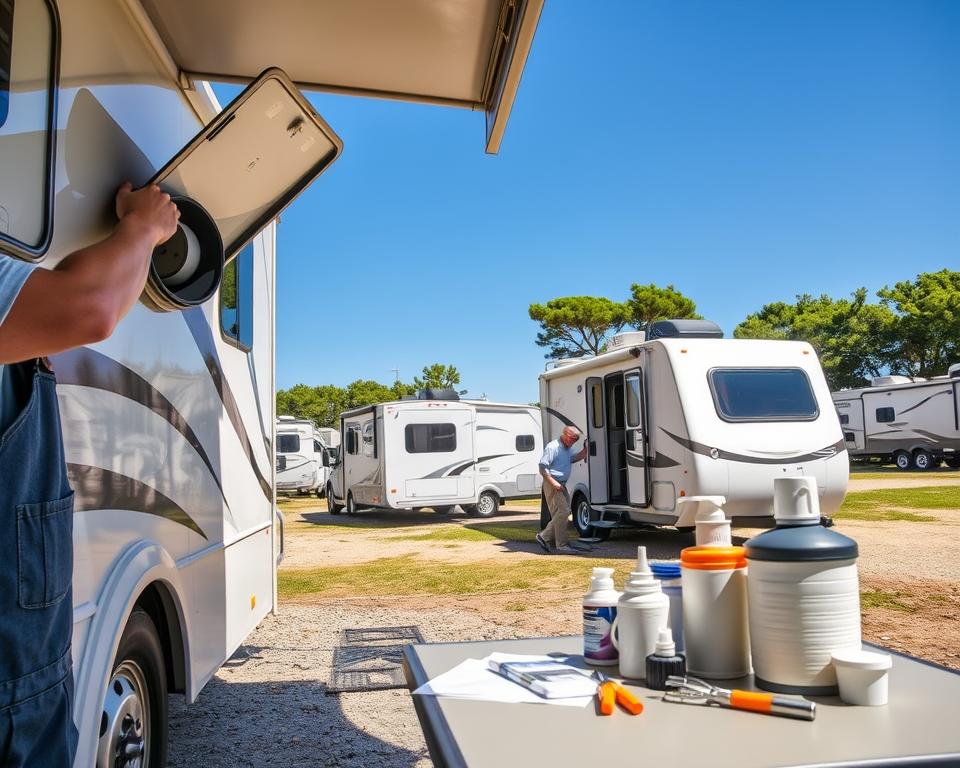Your RV Black Water Tank Pump: Guide and Maintenance Tips
The functionality of your RV black water tank pump is crucial for your travels, have you ever wondered about it? The RV’s sanitation relies heavily on the black water tank pump. For trouble-free journeys, appropriate upkeep is essential. This guide will give you the important information you need to manage your RV waste water pump. Knowing how vital it is will help you boost its efficiency and further enjoy your RV travels.
Critical Findings
- Effective waste management heavily relies on the RV black water tank pump.
- The longevity of your RV waste water pump can be increased through regular maintenance.
- Having knowledge of the system’s components assists in problem-solving.
- For good hygiene and to protect the environment, safe dumping practices are vital.
- Proper winterization of your RV black water tank system can save you money on repairs.
- Maintaining the cleanliness of your RV sanitation pump will help avoid clogs and unpleasant smells.
Grasping RV Water Tank Basics
For trouble-free camping with RV septic pumping, it’s possible that many RV owners don’t fully realize the significance of various water tanks. Understanding the roles of the RV fresh water, gray water, and black water tanks is crucial. Each plays a unique role and needs proper care.
Potable water is kept in the RV fresh water tank. For hydration, cooking meals, and keeping clean, this water is used. The most important thing is to ensure this tank is clean and the water is safe to use. Fresh water is crucial for hydration and health during travels.
The wastewater from sinks and showers is collected in the RV gray water tank. Frequent checks and draining are necessary because this tank can fill up quickly. Proper gray water tank management is essential for a clean RV living space.
This RV black water tank is crucial as it contains toilet waste. To avoid smells and the buildup of waste, constant attention is required. For a better tank condition and experience, use the correct chemicals. Knowing how to care for each tank makes RV trips more enjoyable.
Understanding the RV Black Water Tank Pump’s Role
Recreational vehicle sanitation systems rely heavily on the RV black water tank pump. The pump’s function is to move waste to the appropriate disposal areas. Understanding its operation is crucial for proper maintenance and preventing costly repairs.
There are different types of pumps available for RV owners, such as the sewer pump. A popular option is the macerator pump, as it grinds waste, resulting in quicker disposal. At crowded disposal stations, this is a very useful feature.
It’s vital to have a high-quality RV black tank pump for proper waste management. This pump contributes to a clean and comfortable environment inside the RV. Knowing how your pump works and checking it often will make better your overall RV experience.
Black Water Tank System Components: An Overview
The RV black water tank system must be understood for proper waste management. It involves numerous vital components that work together to ensure smooth functionality. The most critical component, the black water tank, holds waste from the RV’s toilet. Because it’s made of tough materials, it can endure a range of conditions.

A significant function of the system’s pump is to move waste to a designated disposal area. RV owners cannot do without it. Sewer hoses are also crucial, as they provide a flexible connection from the tank to the dump station. These hoses are designed to prevent leaks and contain odors, ensuring a clean disposal process.
For the attachment of sewer hoses, which enables effective waste transfer, connection ports are essential. Controlling the flow of waste is the crucial role of termination valves. During disposal, they stop waste from flowing backward and prevent spills, thus maintaining sanitation.
RV owners can efficiently maintain their sanitation system by learning about these key components. This knowledge is key for troubleshooting issues during travel or use, enhancing the overall RV experience.
Using Your RV Black Water Tank Pump Correctly
Learning to use the RV sanitation pump effectively will profoundly improve your RV living. For a system that runs smoothly, it’s essential to know how to use the black tank correctly. Flushing the tank thoroughly after each use is a critical step. By doing this, you prevent solid waste from accumulating, which could cause blockages and other difficulties.
Ensuring your RV sanitation pump functions as expected requires regular checks. This helps you avoid any bad situations when you’re traveling. Another essential thing is to use toilet paper that is specially made for RVs. This kind of paper is made to break down fast, which lowers the chance of clogs.
Maintaining closed termination valves, except when emptying, is another crucial practice. This helps prevent bad smells. Tank deodorants and cleaners can also be added to help maintain a pleasant smell and cleanliness in the system. Adhering to these guidelines improves your experience with the RV black water tank.
| Best Practices for Black Tank Usage | Advantages |
|---|---|
| Use Lots of Water When Flushing | Reduces the risk of solid waste clogs |
| Make Sure to Regularly Check How the Pump Works | Ensures effective functioning |
| Use RV-Specific Toilet Paper | Lowers the chance of clogs |
| Make Sure to Keep the Termination Valves Shut | Minimizes odors |
| Using Tank Deodorants and Cleaning Agents | Helps the system stay clean and smell good |
Key Maintenance Advice for Your Black Water Tank Pump
Making sure your RV’s black water tank pump is maintained regularly is crucial for its longevity and efficient operation. This involves using the proper chemical treatments that are specially made for these tanks. These treatments are effective at breaking down waste and stopping bad smells.
Ensuring an adequate amount of water is used when flushing the toilet is also critical. It allows waste to flow easily into the tank, thus reducing the possibility of buildup. In addition, it’s important to regularly deep clean the tank and all the parts that go with it. It’s important to use the tools that are recommended for this job.
Keep an eye on the tank levels at all times to prevent problems. Make sure to address any leaks or overflows as soon as you see them. It’s important to empty the tank regularly so that solid waste doesn’t build up. Creating a maintenance schedule helps ensure a trouble-free RV experience.
| Maintenance Task | How Often | Information |
|---|---|---|
| Check levels | With each trip | Ensure the tank is not overfilled to prevent leaks. |
| Apply chemical treatment | Every time you empty it | Add treatments to break down waste effectively. |
| Perform a system flush | On a monthly basis | Make sure to use a cleaning solution to keep the tank clean. |
| Check the pump | Before going on long journeys | Make sure there’s no wear and tear to prevent the pump from breaking down while you’re traveling. |
| Clear out the tank | As needed | It’s best to empty the tank at designated dump stations when it reaches full capacity. |
If you follow these important maintenance steps, your black water tank pump will work properly. This will improve your RV trips significantly.
Troubleshooting Common Problems with Your Black Water Tank Pump
Troubleshooting black tank pump issues can seem daunting. Many people who own RVs run into various issues with their RV black tanks, such as blockages, leaks, or ongoing bad smells. Learning how to handle these problems when they first appear can save you time and prevent costly repairs.
Start by inspecting the hoses connected to the black tank pump. Blockages often occur in these areas, leading to ineffective pumping. Take the hoses apart and look for any buildup or debris inside. Should you find any blockages, clean the hoses thoroughly before you reattach them.
Then, you should assess the seals that are located around the pump and the tank. Leaks can happen if the seals are damaged, and you might not realize it until there’s been a lot of damage. Replace any faulty seals immediately to prevent further issues.
Enzyme treatments can be helpful for odors that keep coming back. By breaking down the waste, these treatments help to reduce the bad smells. For the best outcome, make sure you follow the instructions from the manufacturer.
For your convenience, here’s a table summarizing common issues and how to solve them:
| Issue | Likely Cause | How to Fix It |
|---|---|---|
| Obstructions | Waste material in the hoses or tank | Inspect and clean the hoses |
| Escape of fluid | Seals that are not working properly | Check the seals and replace them if needed |
| Bad smells | Waste buildup | Try using enzyme treatments |
| Pump is not operating | Problems with the electricity | Examine the connections and the battery |
Recognizing the warning signs early on can prevent minor issues from turning into major problems with your RV black tank. If you maintain it regularly and keep a close watch, your black tank pump will last longer, which will improve your RV experience.
Methods for Cleaning Your RV Black Water Tank Pump
It’s vital to maintain the cleanliness of your RV’s black water tank for hygiene and the health of its plumbing system. Aim to minimize odors and ensure everything functions smoothly by rinsing with fresh water after use. This practice helps in reducing the buildup of waste and keeps the tank in good shape.
If you want to clean it more thoroughly, use cleaning products that are specifically designed for black water systems. They work well to break down waste and get rid of odors. Pour water and the cleaning solution into the tank, and allow it to soak. Having a built-in flush system in your RV simplifies the cleaning process.
Driving with sharp turns or using sloshing techniques can help to stir up the contents of the tank. This action helps to loosen any remaining waste that’s stuck to the tank walls. These kinds of cleaning methods help the sensors work better, which can prevent problems related to sewage.
How to Dump Your RV Waste Safely at Dump Stations
It’s important to learn the correct procedures at RV dump stations to keep them in good condition for everyone. When you get to a station, make sure your RV is correctly placed. Then, get your gear ready for dumping.
For a smooth process, make sure to follow these steps closely:
- Ensure your sewer hose is securely attached to the outlet at the station.
- First, open the black water valve to allow the sewage to flow out.
- Close the valve of the black tank after it’s empty. Then, open the gray water valve to clean the hose with the less dirty water.
- When you’re done, carefully take off your hose to avoid any spills.
- Make sure to always clean your hoses with potable water and store them immediately after use.
Following the local laws about how to dispose of waste is also very important. Many places have specific rules that you need to follow to ensure environmental protection. If you don’t obey these laws, you might have to pay fines or face other consequences.
Being considerate at RV dump stations helps to improve the experience for everyone. By maintaining a clean area and adhering to the rules, you demonstrate care for the community. By doing these things, you help create a culture of responsibility among RV enthusiasts and encourage environmentally friendly camping practices.
How to Winterize Your RV Black Water Tank System
To ensure your black water system doesn’t freeze, winterizing your RV tanks is essential. Proper preparation is important to prevent damage caused by water freezing inside the system. Specific steps need to be followed to ensure proper winter care for your RV black tank.
- Begin the process by fully draining the black water tank with the correct pump and connections.
- The next step is to bypass the water heater to stop water from getting in and collecting in it.
- Be sure to use RV antifreeze, because regular antifreeze can be toxic and can harm the environment. Pour the antifreeze into the system according to the product instructions.
- Make sure to leave all faucets and drains open so that any leftover water can get out and the antifreeze can circulate.
- Lastly, make sure all the access panels are sealed and closed tightly so that water can’t get in during the winter.
Following these winterization steps allows RV owners to protect their black water tank systems from the severe impacts of winter. Thinking ahead like this helps to prevent costly repairs or maintenance when the weather changes.
The Final Word
A big part of being a successful RV owner is maintaining your RV black water tank efficiently. Understanding the black water tank pump and following the maintenance plans in this guide will lead to more enjoyable travels. By taking good care of your equipment, you’ll extend its life and simplify the process of managing waste in your RV. This makes travel less daunting.
Knowledge about your RV’s black water system is key to handling issues head-on. Adopting maintenance, troubleshooting, and cleaning methods prevents unexpected malfunctions. This lets you enjoy worry-free road trips. You can get extra help with your maintenance by using reputable services such as All in Sanitation. You can get the essential products and support for top-quality care from them.
Attentiveness and proper care for every part of your RV, including the black water tank, are part of being a good RV owner. Having this information means you’re now ready to explore without any concerns. You’ve done everything correctly to ensure a great trip for yourself and everyone else.

